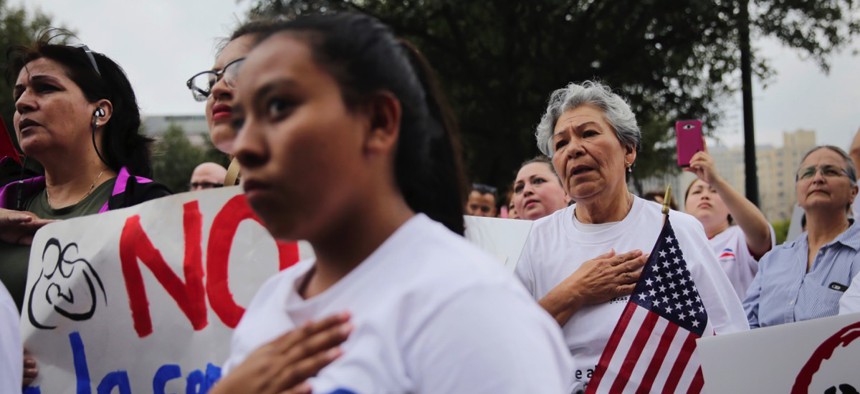The Good, the Bad and the Ugly for Sanctuary Cities

Protesters take part in a No Ban, No Wall immigrant rights rally to oppose a border wall and support sanctuary cities on Feb. 28 outside the State Capitol in Austin, Texas. Eric Gay / AP Photo
“Don’t just comply with these ICE detainers,” the State and Local Legal Center’s executive director advised city leaders. “You’re going to get yourself in a world of hurt if you do that.”
WASHINGTON — If your city has declared itself a “sanctuary city,” know that the term hasn’t been legally defined, and that’s just the first problem with President Trump’s executive order attempting to defund them.
Santa Clara County, California and two cities in Massachusetts have already sued to block the executive order, which State and Local Legal Center Executive Director Lisa Soronen called “short” and “unconstitutional” while discussing immigration reform at the National League of Cities Congressional City Conference in the nation's capital.
The executive order also implies, but does not explicitly state, that local police departments should comply with U.S. Immigration and Customs Enforcement, which Soronen said has caused “a lot of panic and fairly deserved panic.”
“Don’t just comply with these ICE detainers,” Soronen told attendees of the NLC event. “You’re going to get yourself in a world of hurt if you do that.”
By that she meant a possible federal lawsuit for not complying with the Fourth Amendment, which protects the right of people and their property against unreasonable searches and seizures.
When local law enforcement makes an arrest, the suspects’ fingerprints are sent to the Department of Homeland Security and then to ICE, which can and will ask police to detain people. These ICE detainers aren’t warrants, Soronen said, but re-arrest requests that require probable cause to avoid violating the Constitution.
Other oversights within the executive order: Cities are under no obligation to collect information on immigrants for the federal government they don’t already publicize, and any federal grants the Trump administration wants to deny sanctuary cities must be connected to immigration in some way and explicitly state in their language that they can be withheld.
Cities are likely looking at cuts to the federal funding they receive regardless, said Pittsburgh Mayor Bill Peduto, who argued that the U.S. Supreme Court already overturned local law enforcement being required to carry out federal authority, when it struck down a congressional attempt to have police departments register handguns. Power over local police belongs to the states, he added.
“In Pittsburgh we defend the Constitution, not executive orders,” Peduto said.
Instead, Trump’s executive order has people in the city afraid to report crimes, go to the hospital or send their children to school for fear of getting themselves or their family members deported, he said.
Tempe, Arizona has experienced much the same, said city Councilmember Joel Navarro, who added laws targeting immigrants cause them to hide and hinder law enforcement’s ability to form a connection with those communities.
Residents of his city have undoubtedly heard the story of Guadalupe Garcia de Rayos, an undocumented, 35-year-old mother of two teenagers who was recently deported after reporting to ICE. Her children, born in the U.S., are citizens and were left behind.
“You have kids in schools wondering if their parents are going to be there when they get home,” Navarro said. “How do you function worrying about that?”
The fact that many undocumented immigrants felt comfortable enough to call their local leaders, after Trump was elected president, asking for protection shows cities in partnership with police are making inroads, said Monica Fuentes, director of Welcoming America’s D.C. office. Many cities declaring their “sanctuary” city status, despite the lack of a legal definition, do so knowing they need an influx of immigrant workers to remain competitive, she said.
In the next 10 years, the Pittsburgh metro area anticipates a 70,000-person employment shortfall.
“We have a generation that’s missing to take over for people that are retiring,” Peduto said.
Immigrants can fill that void, and Pennsylvania’s chambers of commerce—which often fund Republican campaigns across the state—have applied pressure on legislators to support H-1B visas for students and avoid negatively impacting the economy.
Former Maricopa County Sheriff Joe Arpaio, who advocated for a mass deportation, undoubtedly hurt Tempe’s economy, Navarro said. Immigrants need to be convinced they can find a better life in U.S. cities, he said, which is why “strategic reform” is needed to streamline the immigration process.
At the city level, mayors have found success establishing offices of immigrant affairs or new Americans that coordinate with police and fire to change the way services are delivered, Fuentes said. Resolutions stating city values and a commitment to welcoming immigrants are good entry points to working with those communities and developing policies and programs for them, as well as forging alliances with local churches and philanthropists to combat rising hate crimes and calls for deportation.
A division chief with the Phoenix Fire Department, Navarro said firefighters are often admitted to places police aren’t because they have greater trust with the immigrant community—making partnerships between agencies that much more important.
In the case of Santa Clara County, the Justice Department is asking the U.S. District Court judge not to hear the case because it poses no immediate harm to cities—having not been enforced yet. That makes it that much more important that city leaders arm themselves with knowledge of immigration law and make clear the order’s illegality whenever they can, Soronen said.
“The federal government has limited power to take your money away,” she said. “That executive order is not the final statement . . . And it’s a poor use of federal resources to defend it."
In September 2015, Pittsburgh released a Roadmap for Inclusive Innovation intended to be an “offensive playbook” for engaging immigrants and other disadvantaged groups in the city, Peduto said, but it’s become a “defensive playbook” in the era of Trump. The city is more focused on ensuring the security of its Latino and Muslim populations than empowering them.
The mayor recalled former Pittsburgh Mayor Joe Barker, a corner preacher who rode prevalent nativist and anti-Catholic sentiments into office in 1850 as a write-in candidate while imprisoned. Barker lost his bid for reelection and subsequent mayoral elections, and twelve years later he was beheaded by an oncoming train while walking along railroad tracks. Today Pittsburgh boasts one of the largest Catholic populations of any major U.S. city.
“This is just our time,” Peduto said. “And this is our time to be tested.”
Dave Nyczepir is a News Editor at Government Executive’s Route Fifty
NEXT STORY: State and Local Agencies in Northeast Prep for Big Late-Season Coastal Storm






